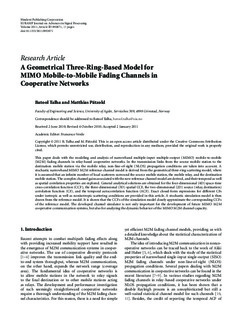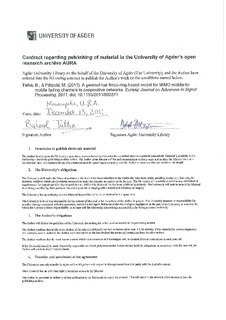| dc.contributor.author | Talha, Batool | |
| dc.contributor.author | Pätzold, Matthias | |
| dc.date.accessioned | 2011-12-13T12:28:36Z | |
| dc.date.available | 2011-12-13T12:28:36Z | |
| dc.date.issued | 2011 | |
| dc.identifier.citation | Talha, B., & Pätzold, M. (2011). A geometrical three-ring-based model for MIMO mobile-to-mobile fading channels in cooperative networks. Eurasip Journal on Advances in Signal Processing, 2011. doi: 10.1155/2011/89287 | no_NO |
| dc.identifier.issn | 1687-6172 | |
| dc.identifier.uri | http://hdl.handle.net/11250/137873 | |
| dc.description | Published version of an article published in the journal: Eurasip Journal on Advances in Signal Processing. Also available from the publisher at: http://dx.doi.org/10.1155/2011/892871. OA | no_NO |
| dc.description.abstract | This paper deals with the modeling and analysis of narrowband multiple-input multiple-output (MIMO) mobile-to-mobile (M2M) fading channels in relay-based cooperative networks. In the transmission links from the source mobile station to the destination mobile station via the mobile relay, non-line-of-sight (NLOS) propagation conditions are taken into account. A stochastic narrowband MIMO M2M reference channel model is derived from the geometrical three-ring scattering model, where it is assumed that an infinite number of local scatterers surround the source mobile station, the mobile relay, and the destination mobile station. The complex channel gains associated with the new reference channel model are derived, and their temporal as well as spatial correlation properties are explored. General analytical solutions are obtained for the four-dimensional (4D) space-time cross-correlation function (CCF), the three-dimensional (3D) spatial CCF, the two-dimensional (2D) source (relay, destination) correlation function (CF), and the temporal autocorrelation function (ACF). Exact closed-form expressions for different CFs under isotropic as well as nonisotropic scattering conditions are provided in this article. A stochastic simulation model is then drawn from the reference model. It is shown that the CCFs of the simulation model closely approximate the corresponding CCFs of the reference model. The developed channel simulator is not only important for the development of future MIMO M2M cooperative communication systems, but also for analyzing the dynamic behavior of the MIMO M2M channel capacity. © 2011 Batool Talha and Matthias Ptzold. | no_NO |
| dc.language.iso | eng | no_NO |
| dc.publisher | Hindawi Publishing Corporation | no_NO |
| dc.subject | mobile-to-mobile fading channels, MIMO channels, space-time cross-correlation functions | no_NO |
| dc.title | A geometrical three-ring-based model for MIMO mobile-to-mobile fading channels in cooperative networks | no_NO |
| dc.type | Journal article | no_NO |
| dc.type | Peer reviewed | no_NO |
| dc.subject.nsi | VDP::Technology: 500::Information and communication technology: 550::Telecommunication: 552 | no_NO |
| dc.source.pagenumber | 1-14 | no_NO |
| dc.source.volume | 2011 | no_NO |
| dc.source.journal | Eurasip Journal on Advances in Signal Processing | no_NO |

